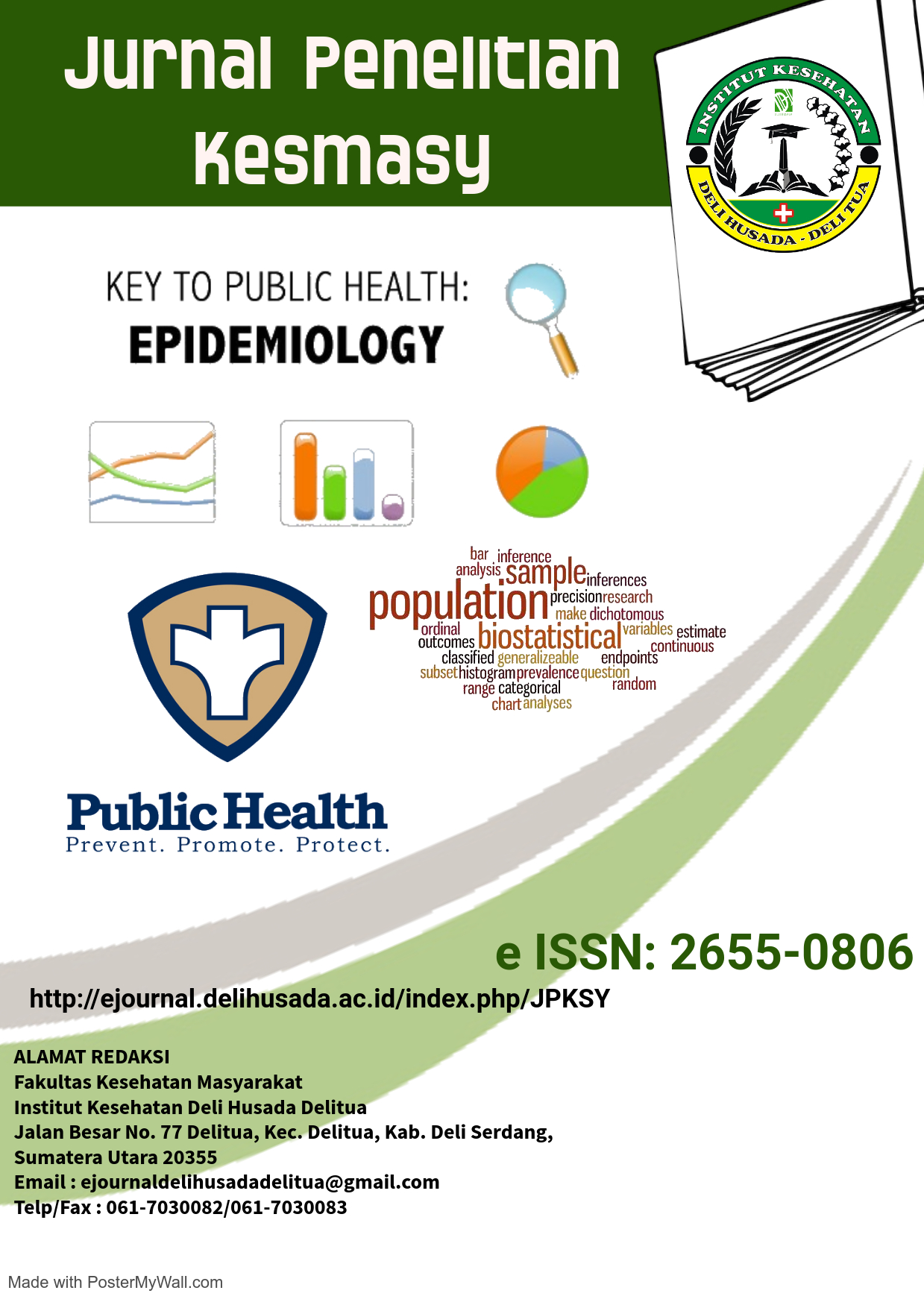THE RELATIONSHIP OF LEAD EXPOSURE RISK TO AGGRESSIVE BEHAVIOR
LLITERATURE REVIEW
Abstract
Lead exposure is a concern that must be addressed by many stakeholders in Indonesia. Lead exposure results in many health problems. With its status as a cumulative toxic substance, lead has the ability to cause a number of significant negative effects on overall public health. Lead exposure has long been suspected as one of the causes of aggressive behavior. However, the underlying mechanism of this impact is not completely understood. Public awareness, especially adolescents, of sources of exposure and assessment of adolescent aggressive behavior is very important because prolonged exposure to lead will prevent adolescents from realizing their potential. The purpose of this study was to conduct an article review focusing on the association between lead exposure and aggressive behavior. Articles were gathered by doing a systematic search of electronic databases such as Google Scholar, PubMed, and MDPI, with publication dates limited to 2019-2023. The keywords utilized were lead, exposure, aggressive behavior. The findings of this literature review indicate a robust link between lead exposure and aggressive behavior in a variety of age groups and populations. In general, the study methods utilized in the selected articles, utilizing both longitudinal cohort and cross-sectional designs, indicated that greater blood or bone lead levels were associated with increased aggression..
Keywords: Lead, Exposure, Behavior, Aggressive
References
Fruh, V., Rifas-Shiman, S. L., Amarasiriwardena, C., Cardenas, A., Bellinger, D. C., Wise, L. A., White, R. F., Wright, R. O., Oken, E., & Henn, B. C. (2019). Prenatal Lead Exposure and Childhood Executive Function and Behavioral Difficulties in Project Viva. Neurotoxicology, 75, 105–115. https://doi.org/10.1016/j.neuro.2019.09.006
Glenn, A. L., Li, Y., & Liu, J. (2022). Association between lower-level of environmental lead exposure and reactive and proactive aggression in youth: Sex differences. Journal of Environmental Science and Health. Part C, Toxicology and Carcinogenesis, 40(3–4), 268–281. https://doi.org/10.1080/26896583.2022.2157183
Liu, J., Portnoy, J., Raine, A., Gladieux, M., McGarry, P., & Chen, A. (2022). Blood lead levels mediate the relationship between social adversity and child externalizing behavior. Environmental Research, 204(Pt D), 112396. https://doi.org/10.1016/j.envres.2021.112396
Martínez-Lazcano, J. C., López-Quiroz, A., Alcantar-Almaraz, R., Montes, S., Sánchez-Mendoza, A., Alcaraz-Zubeldia, M., Tristán-López, L. A., Sánchez-Hernández, B. E., Morales-Martínez, A., Ríos, C., & Pérez-Severiano, F. (2018). A Hypothesis of the Interaction of the Nitrergic and Serotonergic Systems in Aggressive Behavior Induced by Exposure to Lead. Frontiers in Behavioral Neuroscience, 12, 202. https://doi.org/10.3389/fnbeh.2018.00202
Mielke, H. W., Laidlaw, M. A. S., & Gonzales, C. (2010). Lead (Pb) legacy from vehicle traffic in eight California urbanized areas: Continuing influence of lead dust on children’s health. Science of The Total Environment, 408(19), 3965–3975. https://doi.org/10.1016/j.scitotenv.2010.05.017
Obeng-Gyasi, E. (2019). Sources of lead exposure in various countries. Reviews on Environmental Health, 34(1), 25–34. https://doi.org/10.1515/reveh-2018-0037
Rasnick, E., Ryan, P. H., Bailer, A. J., Fisher, T., Parsons, P. J., Yolton, K., Newman, N. C., Lanphear, B. P., & Brokamp, C. (2021). Identifying sensitive windows of airborne lead exposure associated with behavioral outcomes at age 12. Environmental Epidemiology, 5(2), e144. https://doi.org/10.1097/EE9.0000000000000144
Renzetti, S., Cagna, G., Calza, S., Conversano, M., Fedrighi, C., Forte, G., Giorgino, A., Guazzetti, S., Majorani, C., Oppini, M., Peli, M., Petrucci, F., Pino, A., Placidi, D., Senofonte, O., Zoni, S., Alimonti, A., & Lucchini, R. G. (2021). The effects of the exposure to neurotoxic elements on Italian schoolchildren behavior. Scientific Reports, 11, 9898. https://doi.org/10.1038/s41598-021-88969-z
Reyes Sánchez, J. D., Trejo-Valdivia, B., Schnaas, L., Osorio-Valencia, E., Lamadrid-Figueroa, H., Bautista-Arredondo, L. F., Peterson, K. E., Hu, H., & Téllez-Rojo, M. M. (2022). Early life exposure to lead and its association with parent-reported aggression and conduct problems during childhood and adolescence. NeuroToxicology, 93, 265–271. https://doi.org/10.1016/j.neuro.2022.10.008
Sanders, T., Liu, Y., Buchner, V., & Tchounwou, P. B. (2009). Neurotoxic Effects and Biomarkers of Lead Exposure: A Review. Reviews on Environmental Health, 24(1), 15–45. https://www.ncbi.nlm.nih.gov/pmc/articles/PMC2858639/
Sears, C. G., Lanphear, B. P., Xu, Y., Chen, A., Yolton, K., & Braun, J. M. (2022). Identifying periods of heightened susceptibility to lead exposure in relation to behavioral problems. Journal of Exposure Science & Environmental Epidemiology, 32(1), 1–9. https://doi.org/10.1038/s41370-021-00389-3
Tlotleng, N., Naicker, N., Mathee, A., Todd, A. C., Nkomo, P., & Norris, S. A. (2022). Association between Bone Lead Concentration and Aggression in Youth from a Sub-Cohort of the Birth to Twenty Cohort. International Journal of Environmental Research and Public Health, 19(4), 2200. https://doi.org/10.3390/ijerph19042200
Wright, J. P., Lanphear, B. P., Dietrich, K. N., Bolger, M., Tully, L., Cecil, K. M., & Sacarellos, C. (2021). Developmental lead exposure and adult criminal behavior: A 30-year prospective birth cohort study. Neurotoxicology and Teratology, 85, 106960. https://doi.org/10.1016/j.ntt.2021.106960
Yıldız, S., Gözü Pirinççioğlu, A., & Arıca, E. (n.d.). eval_uation of Heavy Metal (Lead, Mercury, Cadmium, and Manganese) Levels in Blood, Plasma, and Urine of Adolescents With Aggressive Behavior. Cureus, 15(1), e33902. https://doi.org/10.7759/cureus.33902







